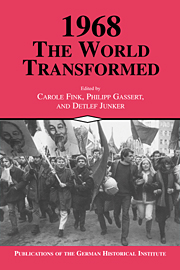18 - 1968 and 1989: Caesuras, Comparisons, and Connections
Published online by Cambridge University Press: 05 January 2013
Summary
Taken as such, one-nine-six-eight and one-nine-eight-nine are merely four-digit numbers without any particular significance. But when considered as years, they can stop conversations by provoking unexpectedly emotional responses because they evoke extraordinary memories: The word “sixty-eight” conjures up images of student protests, occupied buildings, confrontations with the police, or flower children making love not war. References to “eighty-nine” produce associations of harried refugees, courageous dissidents, and powerless Stasi, as well as the overwhelming joy of the fall of the Berlin Wall. The vividness of such pictures implies that these moments possess an emotional charge that has etched them into collective memory beyond the pale recollections of normal existence. But what do these two dates have in common, other than that the number “68” stood on its head makes “89”?
One answer might be that both years signify key caesuras of development after World War II that are especially pronounced in Central Europe. In private conversation, many people date developments in their own lives in reference to these startling events, whether they approve of their consequences or not. In the grand narrative of postwar history, both sixty-eight and eighty-nine mark significant interruptions, places where the story line ruptured, the plot intensified, and the direction altered. As the cliché of “turning points” indicates, such dates are used as shorthand for important and lasting changes that propel events onto a previously unlikely course. In twentieth-century Germany most historical periodization has focused on the world wars and regime collapses of 1918, 1933, and 1945. Despite their profound impact, 1968 and 1989 feel somehow out of place in this enumeration, suggesting that they might possess a different quality.
- Type
- Chapter
- Information
- 1968: The World Transformed , pp. 461 - 478Publisher: Cambridge University PressPrint publication year: 1998
- 1
- Cited by

